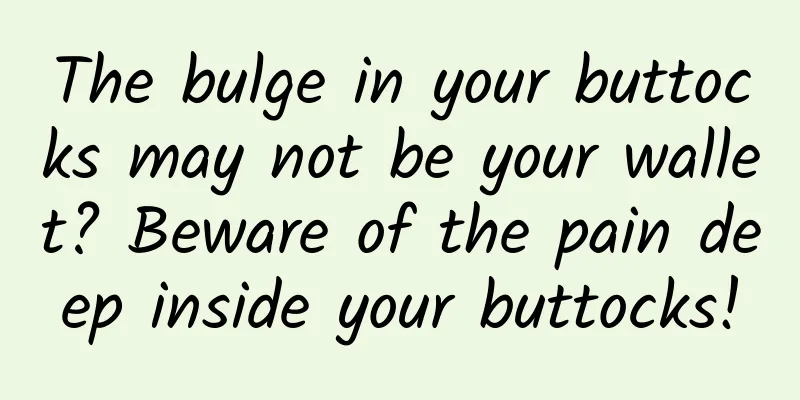The bulge in your buttocks may not be your wallet? Beware of the pain deep inside your buttocks!

|
1. What is “thick wallet syndrome”? In the past, rich people put their wallets in the butt pocket of one side of their pants. The wallets were relatively thick, and they did not need to work. They sat for a long time every day, which over time caused pain in one side of the buttocks. This is the origin of the "thick wallet syndrome", clinically known as piriformis syndrome. 2. How does piriformis syndrome occur? The piriformis muscle is an important muscle located deep in the buttocks. It originates from both sides of the anterior sacral foramen in front of the 2nd to 4th sacral vertebrae, exits the pelvis through the greater sciatic foramen and enters the buttocks. It is located between the greater trochanter of the femur and the sciatic tuberosity, and ends at the greater trochanter of the femur with a narrow tendon. Piriformis syndrome is a group of syndromes mainly caused by sciatica due to mechanical compression of the sciatic nerve caused by damage to the piriformis muscle, or adhesion of this section of the sciatic nerve for some reason. According to the time of injury, it can be divided into acute injury and chronic injury. (1) Acute injury: When the hip joint suddenly adducts and internally rotates, the piriformis muscle is stretched, resulting in piriformis muscle injury, causing local congestion, edema and other inflammatory reactions, which stimulate, stretch or squeeze the sciatic nerve, and then cause symptoms such as pain in the buttocks and legs. (2) Chronic strain: repeated and excessive exercise, such as marathon running, long-distance cycling and other sports that overuse muscles; people who sit for a long time, such as drivers and office workers; people who stand for a long time, such as teachers and cashiers. It causes local muscle fiber degeneration, adhesion and contracture, and due to the involvement of the sciatic nerve and the inferior gluteal nerve, a series of symptoms such as atrophy and weakness of the buttocks and lower limb muscles occur. 3. What are the symptoms of piriformis syndrome? Pain is the main manifestation of this disease, mainly in the buttocks, and can radiate to the lower limbs, mainly to the back or posterolateral side of the lower limb on the same side, and sometimes accompanied by numbness on the outside of the calf, discomfort in the perineum, etc. In severe cases, the buttocks presents a "knife-like" or "burning" pain. 4. What are the treatment options for piriformis syndrome? The main clinical treatment methods include conservative treatment, local blockade and surgical treatment. (1) Conservative treatment: After rest, ice compresses, oral nonsteroidal anti-inflammatory drugs, muscle relaxants and other treatments, the symptoms of most patients with piriformis syndrome are relieved. Through piriformis muscle traction and adductor muscle function training, the support strength and range of motion of the muscles and joints around the piriformis muscle can be increased. Heat therapy, cold therapy, electrotherapy, ultrasonic shock therapy, etc. as auxiliary means of physical therapy are helpful in relieving symptoms. Chinese medicine fumigation, Chinese medicine acupuncture, and massage also have certain therapeutic effects. (2) Local drug injection: Local drug injection can be considered for cases where conservative treatment is ineffective. (3) Surgical treatment: For patients who do not respond to the above treatments, surgical treatment can be considered to cut off the tendinous part at the insertion point of the piriformis muscle and release and explore the sciatic nerve. 5. How to prevent piriformis syndrome? (1) Maintain correct posture in daily life and do warm-up and cool-down exercises before exercise. (2) Avoid actions that may easily induce piriformis syndrome, such as sitting for long periods of time or some activities that twist the trunk, which can easily cause piriformis muscle strain. Pay attention to combining work and rest, change your working posture frequently, and avoid working in a fixed position for long periods of time. (3) Avoid running or exercising on uneven surfaces or hills. Maintain correct posture when running or walking to avoid sprains or strains when falling. If you feel pain in your hips and lower limbs, stop the activity immediately and rest to find the cause of the pain. |
<<: The secret before the shit! This time we opened a box of 38 million-year-old poops
>>: Entering the "flower umbrella world" in the ocean - jellyfish
Recommend
Trends and challenges of digital marketing in 2017!
In 2016, phenomenal cases of digital marketing suc...
Three sisters who didn't smoke got lung cancer one after another! This is very important, but many people do it wrong
Expert of this article: Hu Zhongdong, deputy chie...
Google calls on Apple: Stop secretly modifying user security recommendations
Figure 1: Google AMP pages displayed in Google Se...
Youshe Hand-painting Basic Course Teacher Orange AI Illustration
AI is mainly used for making vector graphics, pos...
Advertising script and running volume formula!
Why does the original material cost hundreds of t...
What are the functions of WeChat Beauty Mini Program? How much does it cost to develop a skin care product mini program?
The most profitable industry nowadays is the &quo...
Baidu Encyclopedia has been with us for ten years. In the future, it will become the world's largest Chinese knowledge base.
More than ten years ago, if you wanted to know so...
Why are mobile phones getting heavier?
In fact, you can find that mobile phones in the p...
Ancient DNA finds answers to the mystery of cattle’s origin and domestication from prehistoric traces (Part 2)
Produced by: Science Popularization China Author:...
Hey, are you ready to welcome the little cutie~ The baby koala is born!
I guess everyone already knows it~ Our little Liu...
How to create a personal account on Douyin
If a personal Douyin account is successfully crea...
What role do microorganisms play in nature?
The ocean has always given people a mysterious fe...
Lose! Hair! Can! Cure! See if you belong to this 90%, come and check your name...
The receding hairline, the piles of hair that I p...
Fission Methodology: How to achieve precise fission and improve paid conversions?
Last week, I helped a friend implement a project....
Tesla is hit back by traditional car manufacturers. Musk is reported to have abandoned his celebrity girlfriend because of his hard work.
What would you do if Hollywood sexy actress Amber...









